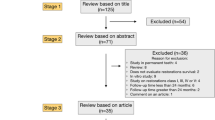Abstract
Study design A double-blind randomised clinical trial, conducted between June 2009 and June 2011, in a paediatric dental department in a Brazilian dental school.
Study selection Children aged 3-8 years, in good general health, with deep carious lesions (caries radiographically located in the inner quarter of dentine) affecting either one or two surfaces in primary molars were eligible for inclusion. Teeth were excluded if clinical or radiographic evidence of pulpal inflammation or necrosis or clinical mobility were observed. Pre-cooperative children were also excluded.
Clinical procedures and success criteria Following a coin toss, 120 teeth were randomly assigned to two groups: 55 in the total caries removal (TCR) group and 65 in the selective caries removal (SCR) group. Procedures were carried out by three paediatric dentists under local anaesthesia and restored, using a layering technique, with composite under rubber dam. Restorations were evaluated at 3, 6, 12, 18, 24 and 36 months, using the US Public Health Service (USPHS) scale, by a single-blinded and calibrated examiner. A Charlie or Delta score, on the USPHS scale, at the margins of the restorations was considered as restoration failure. Gingival bleeding score, type of cavity (one or two surfaces) and presence of caries (active or inactive) were recorded as secondary outcomes; however, presence alone did not constitute restoration failure.
Results Average survival rate of restorations across all teeth was 68% after 36 months, with SCR statistically significantly lower at 57% compared to TCR at 81% (p = 0.004). Annual failure rates for SCR and TCR were 17.3% and 6.7%, respectively. Two-surface restorations had lower survival rates (58%) compared to single-surface restorations (87%) (p = 0.02). Type of cavity and gingival bleeding statistically influenced the chance of restoration failure at 36 months.
Conclusions Composite restorations placed after SCR in primary molars were found to fail more often compared to those restored after TCR. Two-surface cavities and poor gingival health negatively impacted restoration success.
This is a preview of subscription content, access via your institution
Access options
Subscribe to this journal
Receive 4 print issues and online access
$259.00 per year
only $64.75 per issue
Buy this article
- Purchase on Springer Link
- Instant access to full article PDF
Prices may be subject to local taxes which are calculated during checkout
Similar content being viewed by others
References
Maguire A, Clarkson J E, Douglas G V et al. Best-practice prevention alone or with conventional or biological caries management for 3-to 7-year-olds: the FiCTION three-arm RCT. Health Technol Assess 2020; 24: 1-174.
Schwendicke F. Contemporary concepts in carious tissue removal: a review. J Esthet Restor Dent 2017; 29: 403-408.
Franzon R, Guimarães L F, Magalhães C E, Haas A N, Araujo F B. Outcomes of one-step incomplete and complete excavation in primary teeth: a 24-month randomized controlled trial. Caries Res 2014; 48: 376-383.
Rodd H D, Waterhouse P J, Fuks A B, Fayle S A, Moffat M A, British Society of Paediatric Dentistry. Pulp therapy for primary molars. Int J Paediatr Dent 2006; 16(Suppl 1): 15-23.
Cvar J F, Ryge G. Criteria for the clinical evaluation of dental restorative materials. San Francisco: US Department of Health, Education and Welfare, 1971.
Author information
Authors and Affiliations
Rights and permissions
About this article
Cite this article
Goldsmith, R., Taylor, G. & Waterhouse, P. Do composite restorations in primary molar teeth have a higher survival rate following total or selective caries removal?. Evid Based Dent 22, 38–39 (2021). https://doi.org/10.1038/s41432-021-0166-2
Published:
Issue Date:
DOI: https://doi.org/10.1038/s41432-021-0166-2



